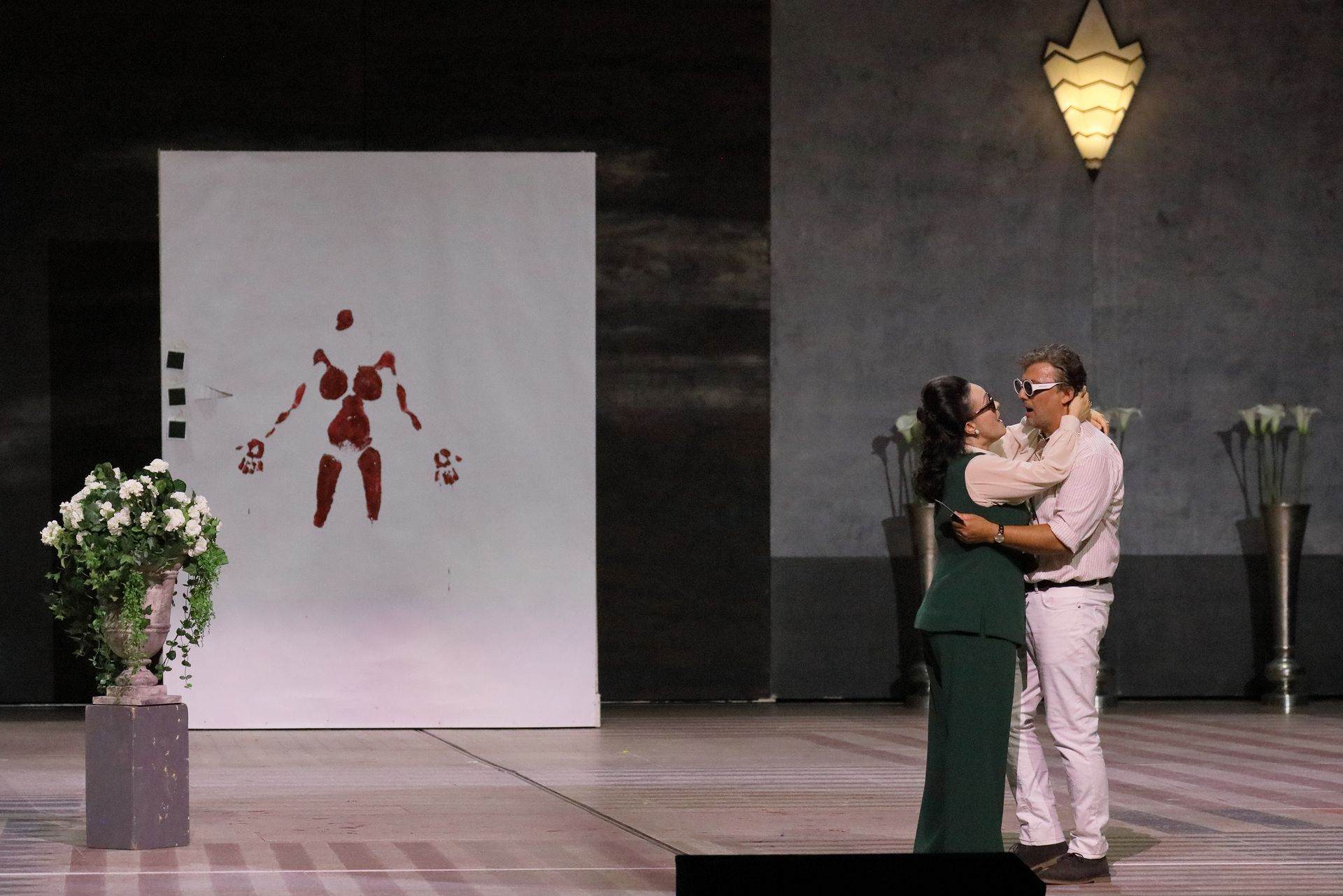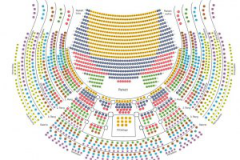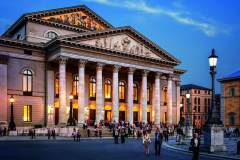Tosca
April 2026 | ||||||
|---|---|---|---|---|---|---|
Mo | Tu | We | Th | Fr | Sa | Su |
Melodrama in three acts
recommended for 16 years and older
In Italian. With German and English supertitles. New Production.
Duration est. 2 hours 40 minutes
There are few operas, which from the very first bar endure such intense pressure, few in which the temperature swings from ice-cold calculation to overheating in mere seconds. And scarcely any in which private entanglement and personal tragedy are so interwoven with political attitudes in historical accuracy. Giacomo Puccini’s Tosca has electrified audiences since its world premiere. The shock wave emitted by the opera was so strong that decades later many reactions still tend to point to the bewilderment and overpowering of those affected rather than the qualities of the piece itself and its love triangle surrounding the singer Floria Tosca, the painter Mario Cavaradossi and the chief of police Baron Scarpia. The artistic world of the protagonist couple, Tosca and Cavaradossi, is no colouristic ingredient here, but rather defines the profile of its characters – it justifies Tosca’s eccentricity, just as it does Cavaradossi’s liberality and also explains the singer’s pronounced self-confidence: The heroine of the stage becomes a heroine in real life. Scarpia’s appearance must also be understood as the emergence of his unleashed totalitarian power, and his sexual sadism still today as one of the truly scandalous moments of opera literature. The historical detail is certainly no staffage, but rather forms the, “precondition of the conflict between the representatives of two opposing social systems” (Norbert Christen) in a time of crisis. With his mish-mash of musical recognition motifs, which, with the exception of the rigid Scarpia chords, sensitively adjust to the situations, Puccini achieves a new dimension of through-composed operatic structure – in the intensive cohesion of the score, he nevertheless creates islands in which reflection compacts itself into moments of the highest possible arioso intensity.
PLOT
Act 1
Rome in June 1800. In the Sant’Andrea della Valle church.
A man in prisoner’s clothes bursts into the empty church where, after a desperate search, he eventually finds a hiding place that has been prepared for him in the Attavanti family chapel.
The sacristan brings brushes, paints and something to eat for Mario Cavaradossi, who is working on a painting of Mary Magdalen. The sacristan thinks he recognises a woman he has seen praying in church recently in the saint’s features. Cavaradossi says he is quite right and broods over the different manifestations of feminine beauty: the blonde Countess Attavanti and his black-haired lover, the opera singer Floria Tosca. The sacristan leaves. The fugitive, believing he is alone again, emerges from the chapel. Cavaradossi sees that it is Angelotti, consul of the overthrown Roman Republic (and Countess Attavanti’s brother), and offers his help. At that moment Tosca bangs on the church door. Cavaradossi, not wanting to take risks, decides not to let her know about the prisoner’s escape. He tells Angelotti to hide again and gives him the basket of food.
Tosca suspects that Cavaradossi has been meeting another woman; he tries to assuage her jealousy. She suggests they spend the evening together after her performance that night but his mind is elsewhere, and his lukewarm reaction rekindles her jealousy. She recognises Countess Attavanti’s face in the painting and feels that her suspicions are justified. Cavaradossi manages to calm her down and persuade her to leave; she demands he paint Mary Magdalen’s eyes black.
Cavaradossi gives Angelotti directions to a hideaway. The boom of a cannon announces that Angelotti’s escape has been discovered. There is no time to lose; Cavaradossi himself will lead Angelotti to his home.
The sacristan brings news to the choristers about the Austrians’ victory over Napoleon’s army and orders that preparations be made for a celebration. The singers rejoice. Baron Scarpia enters with his henchmen and is outraged about the disorder in the church. The intimidated sacristan is questioned; the secret police find Angelotti’s clothes, the empty basket and a fan belonging to Countess Attavanti in the open chapel. Suspicion falls on Cavaradossi. Tosca returns; she can’t meet her beloved later because she is to sing at the celebrations. Scarpia feeds the flames of her jealousy by saying that he found the fan on the painter’s scaffolding. Tosca hurries to Cavaradossi’s house, unwittingly leading Scarpia’s spies to Angelotti’s hiding place. Scarpia indulges in fantasies of lust and power while the choir sings a Te Deum.
Act 2
In the Palazzo Farnese.
Scarpia has sent for Tosca. The police informer Spoletta reports that the search for Angelotti was futile. Cavaradossi was arrested and brought in for interrogation, but he is giving nothing away. A celebratory cantata, with Tosca as soloist, can be heard through the window.
Scarpia commands that Cavaradossi be tortured. Tosca enters just as the painter is being taken away; Cavaradossi begs her to say nothing. She assures Scarpia that her jealousy was unfounded. She is horrified when Scarpia makes it clear to her that her lover is being tortured. Cavaradossi manages to remind Tosca to say nothing, but she cannot bear hearing his cries of pain any longer, and tells Scarpia where Angelotti is hiding. Cavaradossi is brought in unconscious. Scarpia sends Spoletta to get Angelotti. Sciarrone brings the surprising news that reports about the battle near Marengo were misleading, the battle turned and Napoleon was victorious. Cavaradossi erupts in jubilation with his remaining strength, provoking Scarpia; he is led away, his fate seems sealed.
Tosca tries to negotiate a price for Cavaradossi’s release with Scarpia, who is known to be corrupt; but, to her horror, Scarpia demands physical remuneration instead of money. Tosca realises that she has no choice. She reflects on her life and artistry. Spoletta reports that Angelotti has killed himself before he could be captured. Scarpia forces Tosca to decide; she agrees to the deal. Scarpia orders that Cavaradossi be subjected to a sham execution by firing squad, and writes a permit for Tosca and the painter to leave the city after the feigned execution. When Scarpia attempts to embrace her, Tosca makes a lightning decision, grabs a knife from the table, and stabs him. Before she leaves, she places two lighted candles to the right and left of Scarpia's head and places a crucifix on his chest.
Act 3
On the platform of the Castel Sant’Angelo.
The song of a young shepherd is heard in the distance.
Cavaradossi hands over his last possession to a prison warder in order to be allowed to write a farewell letter to Tosca. His thoughts before dying are about her and his love for life.
Unexpectedly, Tosca brings news about the feigned execution and describes how she murdered Scarpia. Both vacillate between apprehension and hope.
While the execution is being prepared, Tosca gives Cavaradossi theatrical instructions that after the shots have been fired he must keep still and play dead until all the soldiers have left.
The firing squad shoots, and Cavaradossi falls. As agreed, Spoletta stops the sergeant from giving him the coup de grace. But, when all have gone, Cavaradossi does not move. Tosca discovers that he really has been shot. Soldiers hurry to the platform: Scarpia’s body has been found, Tosca obviously his murderer. Before she can be seized she leaps from the castle to her death.
Program and cast
Conductor: Marco Armiliato
Director: Kornél Mundruczó
Stage Designer: Monika Pormale
Lighting: Felice Ross
Video: Rūdolfs Baltiņš
Chorus: Franz Obermair
Dramaturge: Kata WéberMalte Krasting
Floria Tosca: Ailyn Pérez
Mario Cavaradossi: Najmiddin Mavlyanov
Baron Scarpia: Ludovic Tézier
Cesare Angelotti: Roman Chabaranok
Der Mesner: Martin Snell
Spoletta: Tansel Akzeybek
Sciarrone: Christian Rieger
Ein Gefängniswärter: Daniel Vening
Stimme eines Hirten: Solist(en) des Tölzer Knabenchors
Bayerisches Staatsorchester
Chorus of the Bayerische Staatsoper
Children's chorus of the Bayerische Staatsoper
Münchner Knabenchor
National Theatre Munich
The National Theatre Munich (German: Nationaltheater München) is an opera house in Max-Joseph-Platz in Munich, Germany. It is the home of the Bavarian State Opera and the Bayerisches Staatsballett(Bavarian State Ballet).
The Bavarian State Opera also performs in the Prinzregententheater, which opened in 1901 and, like the Bayreuth Festspielhaus, is built to Richard Wagner's specifications, and in the Cuvilliés Theatre at the Residenz, constructed in 1751–1753 and described by Thierry Beauvert as "a Rococo gem".
The Nationaltheater is very easy to get to both by car and by MVV public transportation.
By MVV public transportation
S-Bahn: S 1 - 8 Marienplatz
U-Bahn: U 3, 6 Marienplatz, U 3 - 6 Odeonsplatz
Bus: 52, 131 Marienplatz, 100 Odeonsplatz
Straßenbahn: 19 Nationaltheater
On the day of the performance, holders of regular tickets are entitled to use public transport provided by the Münchner Verkehrsverbund (MVV). This service starts at 3 pm respectively three hours before the performance commences and ends with the closing hour of the MVV.
By Car
Take the Altstadt-Ring to Maximilianstraße.
Parking garage Max-Joseph-Platz: open Monday to Sunday from 6:00 A.M. to 2:00 A.M.
You can take advantage of the special theatre parking fee of Euro 10,- from 6:00 P.M. to 8:00 A.M. by presenting your admission tickets.

 EN
EN DE
DE IT
IT FR
FR ES
ES RU
RU JP
JP RO
RO
 Seating plan
Seating plan 

